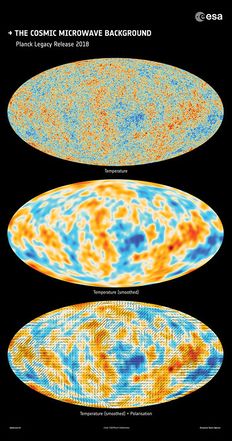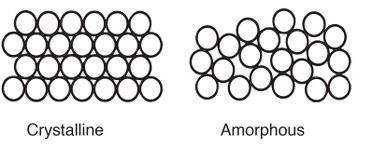Case Studies
On this page multiple recent research studies are described, all of them applying methods from computational topology in different forms. Throughout, a short introduction to the research field background is given, followed by a description of the employed computational topology approach including the most important conclusions.
Astrophysics: Unexpected topology in the Cosmic Microwave Background
Introduction
Though very homogeneous, the Cosmic Microwave Background (CMB), i.e., the electromagnetic radiation filling all space that is a remnant from an early stage of the universe, shows tiny temperature fluctuations. They have been measured in detail for instance via the Planck satellite and are believed to be generated by quantum fluctuations of matter, which subsequently expanded immensely within an inflationary phase. In inflationary theories the universe itself expanded right after the Big Bang to the size of today's observable universe, starting at a size numerous orders of magnitude smaller.
A standard cosmological paradigm is provided by the [math]\Lambda[/math]CDM model, which takes into account a cosmological constant ([math]\Lambda[/math]) and cold dark matter (CDM). By today, the CMB is the most important observational probe for the [math]\Lambda[/math]CDM model's validity. Namely, the [math]\Lambda[/math]CDM model together with inflationary theories predict the CMB temperature fluctuations to be realizations of a homogeneous and isotropic Gaussian random field. While it has largely been agreed upon that the CMB exhibits characteristics of a homogeneous and isotropic Gaussian field, there are lingering doubts.
The study
The topology of excursion sets of maps of the CMB temperature fluctuations is studied in Pranav et al 2018[1], in particular analyzing Betti numbers which quantify the number of connection components and holes. CMB maps observed by the Planck satellite are compared to simulated maps generated according to the theoretical [math]\Lambda[/math]CDM paradigm of cosmology with Gaussian distributed fluctuations.
An important ingredient of their study is that the CMB maps observed are incomplete due to inter alia bright point sources and other extended foreground objects like the milky way. A rigorous method to account for this is the introduction of masks and eventually the introduction of relative homology groups.
Statistical tests such as a parametric [math]\chi^2[/math]-test reveal differences in Betti numbers between observations and simulations with deviations up to [math]3\sigma[/math] to [math]4\sigma[/math]. The authors come to the conclusion, that "beyond the trivial possibility that this may still be a manifestation of an extreme Gaussian case, these observations may motivate to look at primordial non-Gaussianities."
Keywords
CMB temperature fluctuations, excursion sets, Betti numbers, relative homology, testing for non-Gaussianities.
Dynamics on networks: TDA of contagion maps for examining spreading processes on networks
Introduction
Spreading dynamics on networks is a phenomenon with widespread applications ranging from biological epidemics to collective social processes. Two classes of networks are to be contrasted: geometric networks, in which nodes lie in a metric space and are connected by short-range edges constrained by the nodes' locations, and non-geometric networks, whose edges are not constrained by distances between nodes. It is fundamental to question the extent to which the dynamics of for instance contagions on a geometrically embedded network follows the underlying low-dimensional structure, in particular for networks including non-geometric edges. Two different characterizations of contagion spreading exist: wavefront propagation (WFP) and the appearance of new clusters (ANC) that are spatially distant. Long-range transportation networks can for example cause ANC, which can be observed in modern biological epidemics.
Watts threshold model is a suitable model of social contagions, in which the dynamics at any node depends on the states of all neighbouring nodes. Importantly, depending on a chosen threshold for adopting a social contagion WFP can dominate ANC and vice versa.
The study
The spreading dynamics of complex contagions in different Watts threshold models (WTM) on noisy networks with non-geometric edges are studied in Taylor et al 2015[2]. So-called WTM maps are introduced, mapping a node of the network to its activation time in individual realizations of different initial contagion seeds. Bifurcations in WFP and ANC dynamics are analyzed by examining data that are generated by several contagions in a WTM on both, noisy ring lattices and a transit system in London.
Different WFP and ANC regimes are identified for both networks, while the underlying manifold structure can be recovered in terms of its topology, geometry and dimensionality if WFP (strongly) dominates, even in the presence of many non-geometric edges. The latter result is obtained via a Pearson correlation coefficient and via a computational topology approach to the WTM maps by means of investigating the dominating persistent homology classes in Vietoris-Rips complexes. Additionally, a variant of the dimension-reduction algorithm called Isomap is constructed. A comparison to the other regimes in the model's bifurcation diagram of WFP and ANC dynamics is given, highlighting the influence of noisy edges on contagion spreading within networks.
Eventually, the authors strengthen that their "methodology of constructing and analysing contagion maps has important implications not only for the analysis, modelling and control of contagions, but also for other dynamics that can be used to construct filtrations of networks."
Keywords
Contagion spreading, Watts threshold model, contagion maps, Vietoris-Rips complexes, persistent homology, Isomap, London transit network
Material science: Persistent homology for medium-range order in the glass
Introduction
Medium-range order (MRO), i.e. the larger-scale structures beyond neighbouring atoms, plays a much more dominant role in the amorphous structures of glasses than short-range order (SRO), long-range order (LRO) being absent. Although inter alia diffraction analyses yielded evidences for the existence of MRO in these materials, their geometric origins in many-body configurations are not clearly understood such as the "periodicity" of LRO of the "chemical or packing order" of SRO.
Methods employed to date, such as angle distributions and statistics of topological quantities, are often restricted to [math]m(\leq 4)[/math]-body configurations. On the other hand, approaches to topologically quantify amorphous structures such as so-called ring statistics and Voronoi polyhedral analyses have been used in order to characterize atomic configurations of covalent and metallic amorphous solids. However, they require building geometric models based on artificial criteria and do not explicitly extract relevant length scales, turning them not suitable for studying multi-scale phenomena, which are supposed to be important in MRO structures.
The study
Keywords
References
- ↑ PRANAV, Pratyush, et al. Unexpected Topology of the Temperature Fluctuations in the Cosmic Microwave Background. arXiv preprint arXiv:1812.07678, 2018. https://arxiv.org/abs/1812.07678
- ↑ TAYLOR, Dane, et al. Topological data analysis of contagion maps for examining spreading processes on networks. Nature communications, 2015, 6. Jg., S. 7723. doi: 10.1038/ncomms8723


